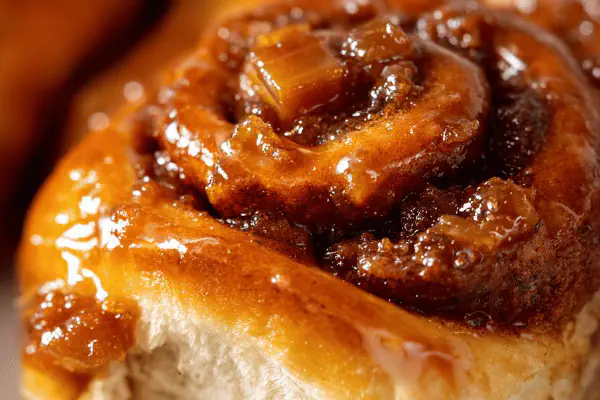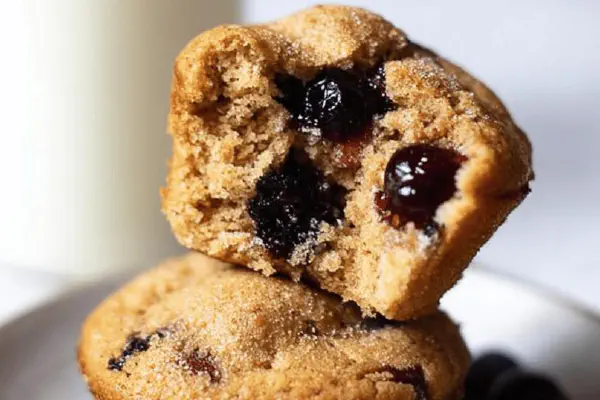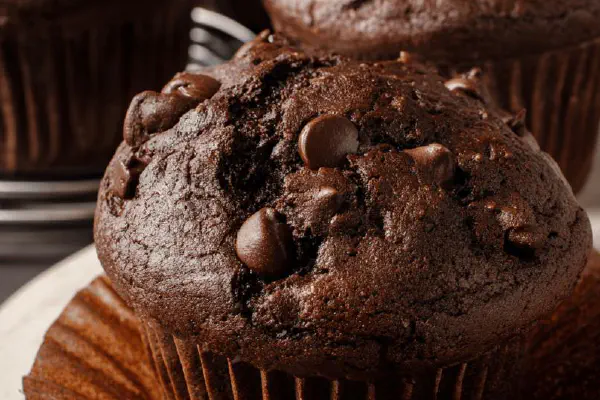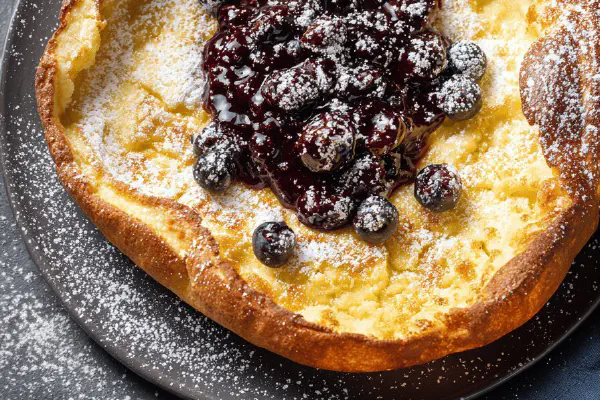Cinnamon Brioche Buns

E
By Emma
Certified Culinary Professional
•
Recipe tested & approved
Sticky buns made from enriched brioche dough. Cinnamon sugar filling, caramel squares topping. Optional cream cheese glaze. Adjusted ingredients with brown sugar replaced by maple sugar and corn syrup replaced by honey for a different flavor. Dough enriched with an extra egg. Fermentation longer or shorter by 5 to 10 minutes. Eight servings.
Prep:
50 min
Cook:
30 min
Total:
Servings:
8 servings
#baking
#pastries
#dessert
Sticky cinnamon buns but richer, softer because of the brioche dough. Extra egg added for depth, texture smoother. Maple sugar swaps brown sugar, offering subtle caramel notes instead of molasses-heavy flavor. Honey replaces corn syrup, naturally sweet with floral hints. Dough needs resting - patience matters. Over-proof a bit and buns get heavier, under-proof and they’re dense. Rolling out to precise rectangle – 48 x 28 centimeters. Even butter spread, packed cinnamon sugar in layers. Cut rolls prone to squish so space slices carefully in buttered pan. Chill caramel slab for firm squares that melt perfectly on baking buns. Optional cream cheese glaze for tangy finish. Not mandatory but highly recommended. Time frames flexible by five to ten minutes either way; slight delays will not ruin the bake. Oven temperature slightly lower to maintain caramel’s glossy texture. Get ready for sticky fingers. Almost dessert, almost breakfast, almost sin. Grab coffee.
Ingredients
Brioche Dough
- 315 g unbleached all-purpose flour (2 1/3 cups)
- 40 g maple sugar (1/5 cup)
- 6 ml instant yeast (1 1/4 tsp)
- 2 ml fine salt (1/2 tsp)
- 140 ml warm water (just under 2/3 cup)
- 3 eggs
- 245 g unsalted butter, softened (1 cup plus 3 tbsp)
- 125 g light brown sugar (scant 2/3 cup)
- 18 ml ground cinnamon (1 1/4 tbsp)
Caramel
- 70 ml heavy cream 35%
- 25 g maple sugar (2 tbsp)
- 15 ml honey (1 tbsp)
- 25 g unsalted butter
Glaze (optional)
- 100 g cream cheese, softened
- 20 ml unsalted butter, softened
- 110 g powdered sugar (3/4 cup)
- 1 ml vanilla extract (optional)
About the ingredients
Flour quantity adjusted smaller by roughly 30 percent; less flour keeps dough tender. Using maple sugar adds unique taste plus a bit of moisture retention. Instant yeast slightly reduced for longer fermentation time; flavors develop deeper. Salt measured with care. Butter divided into two parts: first for dough enrichment, second for spreading on rolled out dough. Brown sugar replaced by light brown sugar for slight sweetness tweak. For caramel, maple sugar replaces white or brown sugar for richness; honey instead of corn syrup introduces nuanced sweetness and less processed sugar alternatives. Cream is 35% fat for silkiness; butter quantity in caramel reduced slightly to avoid excess greasiness. Cream cheese and butter amount reduced in glaze, powdered sugar adjusted. Vanilla optional to add aromatic complexity.
Method
Dough Base
- 1. Mix flour, sugar, yeast, salt in mixer bowl with dough hook or wooden spoon. Dump in water and eggs. Blend until shaggy ball forms.
- 2. Add half the butter. Knead 5-7 minutes on stand mixer or floured surface until dough is soft, slightly sticky but not wet.
- 3. Place dough in greased bowl, cover with damp cloth or plastic. Keep warm and draft-free. Let rise about 1h 20m until doubled.
- 4. While rising, mix cinnamon and brown sugar in small bowl.
- 5. Butter a 33x23 cm pan.
- 6. On floured surface, roll dough to 48x28 cm rectangle.
- 7. Spread remaining butter over dough evenly. Sprinkle cinnamon sugar on top.
- 8. Roll dough from short side to form 28 cm log, not too tight. Cut into 8 equal pieces.
- 9. Arrange slices upright, slightly apart, in pan. Cover with plastic. Let rest 55 minutes or until nearly doubled.
- 10. Option: refrigerate up to 10 hours after second rise. Remove, warm 25 minutes before baking.
Caramel Preparation
- 11. Draw 28x12 cm rectangle on back of parchment paper. Flip paper over.
- 12. Heat cream, maple sugar, honey in saucepan. Boil gently about 3-4 minutes until deep amber color.
- 13. Remove from heat; stir in butter until blended.
- 14. Pour caramel into parchment rectangle. Place another parchment on top. Roll thin and even. Chill until set.
- 15. Peel top parchment. Slice caramel into 8 squares.
Baking
- 16. Preheat oven to 175°C (345°F). Position rack center.
- 17. Place one caramel square on each bun.
- 18. Bake approximately 27 minutes or until golden brown and puffed.
- 19. Cool in pan on wire rack.
Optional Glaze
- 20. Beat cream cheese and butter till smooth.
- 21. Gradually add powdered sugar on low speed until creamy. Add vanilla if using.
- 22. Spread over warm buns before serving. Best eaten same day.
Cooking tips
Start with dry ingredients, adding wet last. Gentle mix creates less gluten development but enough for brioche’s fluffiness. Kneading time may vary slightly depending on mixer or hand. Dough consistency sticky but manageable. Bulk rise in a warm spot, avoid drafts to encourage it to almost double. Prepare cinnamon sugar while waiting. Roll dough on generously floured surface so it doesn’t stick; rectangle exactness affects even spiral layers. Don’t over-roll or butter melts prematurely. Roll tight enough to hold shape but loose enough to stay light. Cutting rolls uniform thickness to encourage even baking. Let proof second time until visibly puffed, loosely covered to keep moisture. Caramel cooking involves close attention; boiling until amber to hit soft crack stage but avoid scorched taste. Pour between parchments case you want thin slabs. Chill fully before slice to prevent sticking. Preheat oven to 175°C which is a touch lower to protect caramel squares from burning; bake until buns golden and caramel slightly bubbling. Cooling in pan lets caramel set properly. Optional glaze with creamed cheese smoothed before serving for balance. Best if enjoyed day of baking. Refrigeration up to 10 hours allowed but restore warmth prior baking.
Chef's notes
- 💡 Use a stand mixer, dough hook for better mixing. Hand knead if needed, but keep it gentle. Dough should be soft, not overly sticky. Room temperature butter crucial for even spread. Don't rush the rises. Longer is better for flavor and texture. Roll dough on plenty of flour. Exact 48x28 cm size crucial for even layers.
- 💡 Cinnamon sugar ratio matters. Adjust sweetness based on preference. Chill dough after shaping, if not baking immediately. It firms up nicely. Caramel cooking requires attention. Wait for that amber color. Don’t burn. Cooling time essential for proper setting. Use parchment between layers when chilling.
- 💡 For the glaze, cream cheese should be very soft. Mix until completely smooth to avoid lumps. Gradually add sugar for the best texture. Vanilla gives a nice finish, but optional. Serve buns warm for best flavor experience. Keep leftovers sealed but consume quickly. Stale buns not good.
- 💡 Patience in proofing changes everything. Too short a rise will lead to dense buns. Take note of room temp; it impacts yeast activity. Watch for puffiness before baking. Oven temp correct? Yes, check with thermometer. Cool in pan to help caramel set nicely. Rely on your senses too.
- 💡 Last tip: Experiment with fillings! Consider nuts or chocolate for variation. Shape doesn't need to be perfect. Slightly irregular adds charm. Don’t stress. Keep trying. Each bake is a lesson, learn how dough feels. Adjust baking time based on your oven's quirks. Calibration is key.
Common questions
How to get the right dough consistency?
Stickiness is ok. Soft dough important. Mix until shaggy, then knead till smooth. Watch not to over-knead.
Can I prepare the dough in advance?
Yes, but refrigerate after shaping. Bring back to room temp before baking. This keeps texture right.
What if my buns don't rise enough?
Check yeast freshness first. Warm environment helps. Keep covered while proofing, avoid drafts.
How should I store the leftovers?
Leave at room temp for a day. For longer, wrap tightly and refrigerate. Reheat before eating for softness.



